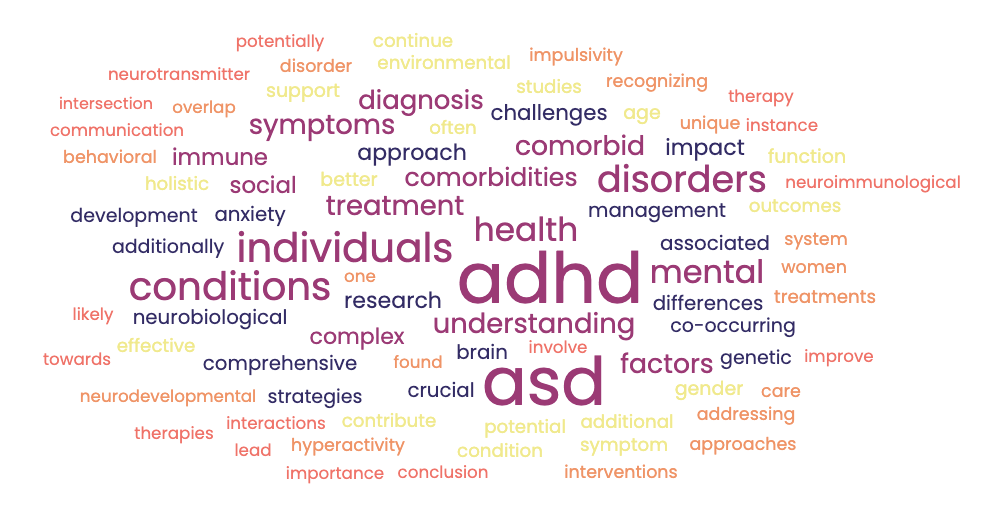Abstract
This blog provides a comprehensive exploration of how Attention-Deficit/Hyperactivity Disorder (ADHD) and Autism Spectrum Disorder (ASD) are frequently accompanied by additional mental health conditions. The co-occurrence of these conditions poses unique challenges for diagnosis, treatment, and management, which we’ll explore throughout the text. We’ll also touch upon the potential underlying factors that may contribute to this overlap and discuss potential strategies for addressing these complex cases.
Introduction
Both ADHD and ASD are prevalent neurodevelopmental disorders that significantly impact affected individuals. A notable concern is the high occurrence of additional mental health conditions that frequently accompany these disorders. This intricate web of comorbidity underscores the necessity for a nuanced understanding of each condition’s implication on mental health. This blog aims to highlight the intersection of ADHD, ASD, and comorbid mental health disorders. We’ll explore the prevalence, diagnostic challenges, and potential underlying factors of this overlap.
The Complex Relationship Between ADHD, ASD, and Comorbid Mental Health Disorders
ADHD and ASD are complex conditions that interact with each other in intricate ways. Research suggests a high rate of co-occurrence between these two diagnoses. One study found that over half of children with ASD also had a comorbid ADHD diagnosis. Likewise, numerous studies have found that individuals with ADHD are more likely to exhibit symptoms of ASD than the general population.
While these two disorders share some overlapping symptoms, they also have distinct features that can coexist and contribute to additional mental health conditions. For example, impulsivity is a common symptom in both ADHD and ASD, but the impulsivity in ADHD is largely driven by hyperactivity and impulsiveness, whereas it may manifest differently in individuals with ASD. These differences can result in distinct comorbidities for each condition.
Exploring ADHD and Comorbid Mental Health Disorders
Conditions such as anxiety, depression, and behavioral disorders are commonly linked to ADHD. These comorbidities can complicate the clinical picture, often influencing the approach to both diagnosis and intervention strategies. For instance, individuals with ADHD and co-occurring depression may experience more severe symptoms and poorer academic outcomes than those with ADHD alone.
The relationship between ADHD and anxiety is particularly complex. While it’s estimated that 20% to 25% of individuals with ADHD also have an anxiety disorder, the specific connection between the two is still not well understood. Researchers suggest that the impulsivity and inattention associated with ADHD may increase the risk of anxiety as individuals struggle to manage their symptoms. Additionally, studies have found that children with both ADHD and anxiety experience more significant impairment in social functioning than those with only one condition.
Understanding ASD and Comorbid Mental Health Disorders
ASD, likewise, is associated with a spectrum of mental health issues. Recognizing and effectively addressing these additional challenges requires an appreciation of the unique attributes of ASD and the complexities introduced by comorbidity. Individuals with ASD may struggle with social interactions, communication, and sensory processing. These challenges can contribute to the development of additional mental health conditions, such as anxiety, depression, and obsessive-compulsive disorder.
Overlap and Interplay of ADHD, ASD, and Comorbid Mental Health Disorders
The intricate overlap between ADHD, ASD, and co-occurring mental health issues fosters a convoluted interplay of factors. It is essential to discuss the influence of genetic, environmental, and neurobiological contributors in the context of these comorbidities. Additionally, there is an abundance of evidence that suggests the impact of each condition differs depending on the individual’s age and gender. We’ll explore these nuances in the following sections.
Genetic, Environmental, and Neurobiological Contributors
The etiology of ADHD, ASD, and their respective comorbidities involve a complex interaction of genetic, environmental, and neurobiological factors. Genetics play a significant role, with numerous studies illustrating a hereditary component to both ADHD and ASD. For instance, familial studies have suggested that the relatives of individuals with ADHD or ASD have a higher likelihood of being diagnosed with the condition themselves, indicating potential genetic predispositions.
Environmental factors also contribute to the development and severity of these conditions and their comorbidities. Prenatal exposure to toxins, premature birth, and low birth weight have been identified as risk factors. Furthermore, stressful life events, particularly in early childhood, may exacerbate symptoms or trigger the onset of comorbid conditions.
Neurobiologically, abnormalities in brain structure and function have been observed in individuals with ADHD and ASD. Differences in areas of the brain involved in attention, executive function, and social cognition have been noted, which may help explain the overlap in symptoms and the occurrence of comorbid conditions. Additionally, neurotransmitter imbalances have been implicated in both disorders, suggesting that altered neurochemical signaling could be a common thread.
Neurobiological Factors in ADHD and ASD
The neurobiological underpinnings of ADHD and ASD are critical to understanding the complexity and diversity of these conditions. Research into brain structure and function has revealed significant insights into the neurobiological factors that contribute to both disorders. In individuals with ADHD, neuroimaging studies have consistently shown anomalies in the frontal cortex, particularly regions associated with executive function and impulse control. This aligns with the symptoms of inattention, impulsivity, and hyperactivity characteristic of ADHD.
For ASD, the picture is slightly different but equally complex. Variations in brain structure and connectivity have been observed, especially in regions that govern social interactions and communication. This includes areas such as the amygdala, which is involved in emotional regulation, and the fusiform gyrus, which plays a role in facial recognition and social cues decoding. These alterations could contribute to the social and communication difficulties that define ASD.
Furthermore, neurotransmitter systems, the chemical messengers of the brain, show irregularities in both disorders. Dopamine, a neurotransmitter associated with motivation and reward, is often cited in discussions of ADHD, reflecting its role in attention and executive function. In ASD, serotonin, a neurotransmitter important for mood, sleep, and digestion, might be out of balance, which could potentially relate to issues with anxiety, mood disorders, and sensory processing.
Recent advances in neuroimaging and genetic research continue to enhance our understanding of these neurobiological factors. By unraveling the complexities of brain function and structure in ADHD and ASD, researchers hope to pave the way for more targeted and effective interventions, potentially mitigating the impact of these conditions on individuals’ lives. So, knowledge of these factors is crucial in providing holistic care for individuals with ADHD and ASD.
Neuroimmunological Factors in ADHD and ASD
An emerging area of research that holds promise for a deeper understanding of ADHD and ASD is the examination of neuroimmunological factors. This line of inquiry explores how the immune system’s interactions with the central nervous system may influence the development and progression of these conditions. There is growing evidence that immune dysregulation can have profound effects on neurodevelopment, potentially contributing to the manifestations of ADHD and ASD. For instance, studies have shown that certain autoimmune disorders and maternal immune activation during pregnancy are associated with an increased risk of ASD in offspring. Similarly, inflammation and altered immune responses have been observed in individuals with ADHD, suggesting that immune system abnormalities could play a role in its pathophysiology. Further research in this area could lead to the development of novel interventions aimed at addressing immune system dysregulation and potentially mitigating ADHD and ASD symptoms.
The intriguing relationship between neuroimmunological processes and the etiology and treatment of ADHD and ASD underscores the complex interplay between the immune system, brain development, and brain function. The neuroimmunological underpinning suggests that immune system anomalies can not only predispose individuals to these neurodevelopmental disorders but also influence the severity and manifestation of symptoms. This understanding opens avenues for innovative diagnostic and therapeutic strategies that target immune dysregulation.
For example, the presence of specific biomarkers associated with immune dysfunction could potentially aid in the early diagnosis of ADHD and ASD, enabling timely intervention. Furthermore, treatments that modulate the immune response, such as anti-inflammatory medications or therapies aimed at correcting autoimmune imbalances, could offer new hope for managing these conditions more effectively. This perspective on treatment is especially compelling given that conventional approaches primarily focus on symptom management through behavioral therapy and pharmacological interventions targeting neurotransmitter systems. Exploring the potential of therapies that address neuroimmunological factors could lead to more holistic and personalized treatment plans, reflecting the diverse etiological landscapes of ADHD and ASD.
Thus, the intersection of neuroimmunology with ADHD and ASD not only enriches our understanding of these disorders but also heralds a paradigm shift in how we approach their diagnosis and treatment, emphasizing the importance of integrating interdisciplinary research for comprehensive care.
Research into the neuroimmunology of ADHD and ASD is still in its nascent stages but offers a promising avenue for unraveling the complex etiologies of these conditions. Understanding the interactions between the immune system and brain development could lead to new therapeutic strategies aimed at modulating immune function to alleviate symptoms or prevent the onset of these neurological disorders.
Age and Gender Differences
The prevalence of ADHD, ASD, and their comorbidities varies based on age and gender. For example, boys are more likely to be diagnosed with ADHD than girls in childhood, but this gender gap narrows by adulthood. In contrast, the opposite is true for ASD, where boys continue to have a higher rate of diagnosis throughout their lifespan. This suggests that there may be gender-specific factors at play in the development and presentation of these conditions.
Additionally, the symptoms and comorbidities associated with ADHD and ASD can change as individuals age. For instance, hyperactivity tends to decrease in adolescents with ADHD, while symptoms such as difficulty sustaining attention and executive functioning challenges may persist into adulthood. Similarly, individuals with ASD may develop coping strategies and improve social skills as they age, but may also experience an increase in anxiety or depression.
Men and women often present with ADHD and ASD in varied ways, reflecting differences in symptomatology and coping mechanisms. Women with ADHD, for instance, may exhibit more internalizing symptoms such as inattention, difficulty with time management, and disorganization. Conversely, men are often more likely to show externalizing behaviors like hyperactivity and impulsivity. This difference in symptom presentation can lead to underdiagnosis or misdiagnosis in women, as their symptoms may be less overt or conform less to the traditional understanding of ADHD.
Similarly, in the context of ASD, women often develop more sophisticated social coping strategies than their male counterparts, which can mask underlying difficulties with social communication and interaction. Women with ASD might be better at mimicking social behaviors and may have a more nuanced understanding of social contexts, despite experiencing similar challenges internally. These nuanced differences highlight the importance of gender-sensitive approaches in the diagnosis and treatment of both ADHD and ASD.
In conclusion, ADHD and ASD are complex conditions that often co-occur with other mental health disorders. The interplay between these comorbidities is influenced by genetic, environmental, and neurobiological factors. Additionally, age and gender differences can impact the presentation and management of these conditions. Understanding these nuances is vital for providing effective care to individuals with ADHD, ASD, and their comorbidities. By recognizing the interconnectedness of these disorders and tailoring treatment accordingly, we can enhance outcomes and improve the lives of those affected by them. So let’s continue to deepen our understanding of these conditions and work towards supporting individuals with ADHD, ASD, and their co-occurring mental health challenges.
Current Treatment Approaches for ADHD and ASD
Currently, treatment approaches for ADHD and ASD are multifaceted, taking into account the wide array of symptoms present and the often complex nature of comorbid conditions. For ADHD, treatments typically encompass a combination of medication, behavioral therapy, and, in some cases, lifestyle adjustments. Stimulant medications like methylphenidate and amphetamine are commonly prescribed and have been found to be effective in reducing core symptoms of hyperactivity and impulsivity. Non-stimulant medications are also available and may be preferred in certain scenarios, especially when stimulants are not well-tolerated. Behavioral interventions focus on improving time management, organizational skills, and reducing disruptive behaviors.
In contrast, treatments for ASD are more focused on improving communication skills, social interactions, and addressing behavioral challenges. Early intervention with therapies such as mental health therapies, occupational therapy, and speech therapy can be particularly beneficial. These treatments are often tailored to the individual’s needs and can involve both one-on-one and group therapy settings. There is also an emphasis on educational support and interventions that facilitate learning and inclusion in school settings.
For individuals with co-occurring ADHD and ASD, a coordinated approach that addresses both sets of symptoms is necessary. This may involve a combination of medications, behavioral therapies, and educational supports designed to meet the unique needs of the individual. It’s crucial to regularly monitor progress and adjust treatments as needed, given the dynamic nature of these conditions and their impact on different life stages. Collaboration among healthcare providers, educators, and families is essential to crafting a comprehensive and effective treatment plan.
Impact on Diagnosis
The presence of comorbid mental health disorders can significantly impact the diagnosis of ADHD and ASD. These additional conditions may mask or mimic symptoms, making it challenging to determine the primary disorder. In some cases, individuals with co-occurring conditions may not receive an accurate diagnosis at all, leading to suboptimal treatment and support.
One study found that individuals with ADHD and ASD were less likely to receive an accurate diagnosis than those with only one condition, highlighting the need for increased awareness and understanding of comorbidity in clinical settings. Additionally, studies have shown that men are more likely to be diagnosed with both ADHD and ASD, while women may be underdiagnosed or misdiagnosed due to differences in symptom manifestation and societal expectations of gender roles.
It’s essential for healthcare professionals to conduct thorough assessments and consider the possibility of comorbid conditions when diagnosing ADHD or ASD. This may involve gathering information from multiple sources, including family members, teachers, and previous medical records. Recognizing the complexity of these disorders and their co-occurring conditions is crucial for accurate diagnosis and effective treatment.
Future Directions
As research continues to shed light on the complexities of ADHD, ASD, and their comorbidities, there is a growing need for tailored treatment approaches that address the unique needs of individuals. This includes understanding how genetic variations may impact symptom presentation and response to treatments, as well as identifying environmental factors that may contribute to the development of these conditions.
Additionally, more research is needed on the impact of age and gender differences in the diagnosis and treatment of ADHD and ASD. This includes understanding how hormonal changes may influence symptom severity and response to treatments, as well as recognizing the potential for societal biases and expectations to affect diagnosis and support for individuals with these disorders.
In conclusion, while there is still much to learn about ADHD, ASD, and their co-occurring conditions, it’s evident that a comprehensive and individualized approach is necessary for effective management. By recognizing the interconnectedness of these disorders and acknowledging the nuances of age and gender differences, we can continue to improve outcomes and provide better support for individuals with ADHD, ASD, and their comorbidities.
Challenges in Diagnosis and Treatment
The presence of comorbid mental health conditions can complicate the diagnosis and treatment of ADHD and ASD. It is crucial to consider these additional factors when assessing individuals with neurodevelopmental disorders. For example, the treatment approach for ADHD may differ significantly when individuals also have an anxiety disorder. In these cases, addressing both conditions simultaneously can lead to better outcomes.
Furthermore, comorbidities can exacerbate symptoms and impair functioning, making it challenging for individuals with ADHD or ASD to manage their condition effectively. This compounded impact highlights the importance of a comprehensive treatment plan that addresses all comorbidities.
The Importance of a Holistic Approach
Given the complexities associated with ADHD, ASD, and comorbid mental health conditions, it is crucial to take a holistic approach when diagnosing and treating these individuals. This includes considering the impact of genetic, environmental, and neurobiological factors, as well as addressing any co-occurring mental health issues. A collaborative and multidisciplinary approach involving healthcare professionals, educators, and families is essential in providing comprehensive care for these individuals.
The impact of ADHD, ASD, and their associated comorbidities can be far-reaching and lifelong. Therefore, it is crucial to not only focus on symptom management but also address the individual’s overall well-being and quality of life. This may involve interventions such as mindfulness practices, social skills training, and support groups that promote self-awareness, emotional regulation, and positive coping strategies.
In conclusion, a holistic approach that considers all aspects of an individual’s health and well-being is necessary for effective management of ADHD, ASD, and their comorbidities. With continued research and collaboration among healthcare professionals, educators, and families, we can continue to improve outcomes and support individuals with these complex conditions. In essence, it is crucial to recognize the interconnectedness of these disorders and provide comprehensive care that addresses the unique needs of each individual. So, the journey to better understanding and managing ADHD, ASD, and their comorbidities continues. Let’s keep striving towards a brighter future for all individuals affected by these conditions.
Conclusion
Summarizing the core themes of the article, it highlights the imperative for integrated care approaches. In the realm of neurodevelopmental disorders and mental health, practitioners and caregivers must adopt comprehensive strategies to facilitate better outcomes for individuals faced with these challenges. The direction for future research and clinical practices is aimed at enhancing our understanding and management of these complex condition intersections. Additionally, it is crucial to recognize the diversity of experiences within these populations and address any potential biases in diagnosis and treatment. By taking a holistic approach, we can better support individuals with ADHD, ASD, and comorbid mental health disorders on their unique journeys towards improved well-being. In conclusion, this blog serves as a starting point for further exploration and dialogue on the intersection of ADHD, ASD, and comorbid mental health disorders. Through continued research and collaboration, we can continue to improve our understanding and approach towards supporting individuals with these complex conditions. It is crucial to prioritize a comprehensive and inclusive perspective in clinical practice, education, and policy-making to promote better outcomes for those affected by these challenging neurodevelopmental disorders. Overall, this blog highlights the importance of recognizing the interconnectedness of ADHD, ASD, and comorbid mental health conditions and the need for a holistic approach to support individuals living with these challenges. So let’s continue to work together towards better understanding and supporting all individuals struggling with ADHD, ASD, and comorbid mental health disorders.








